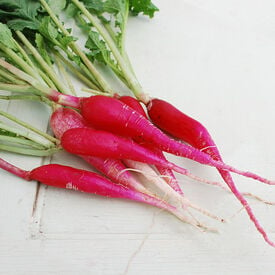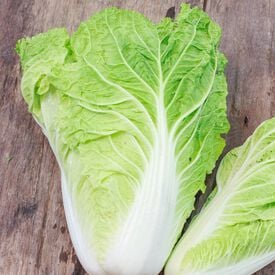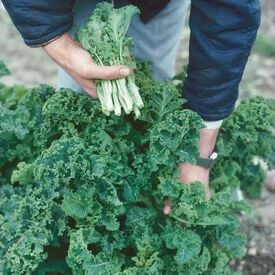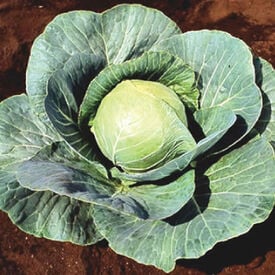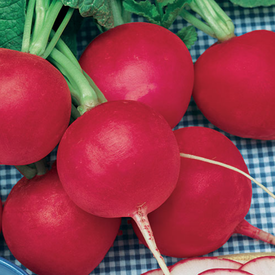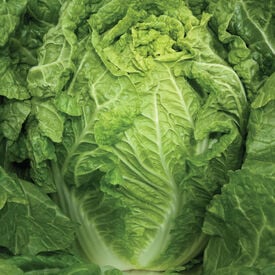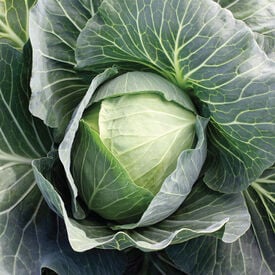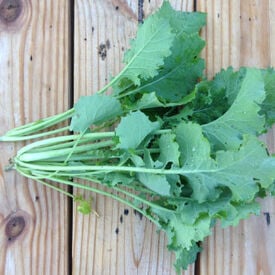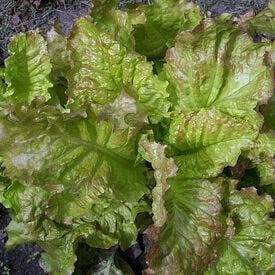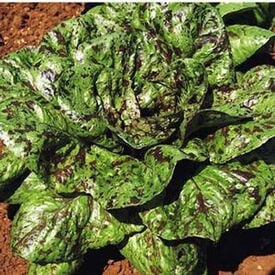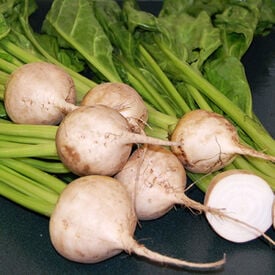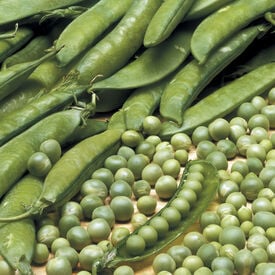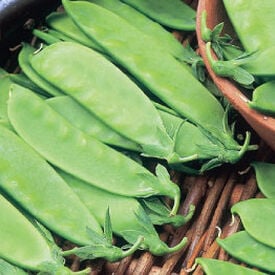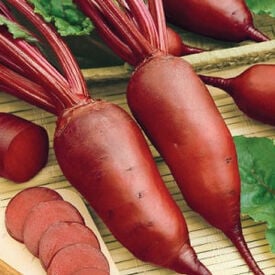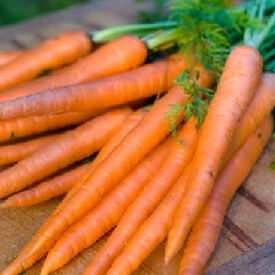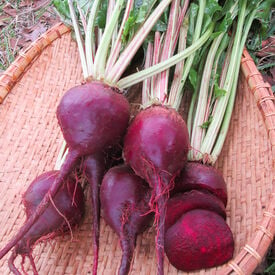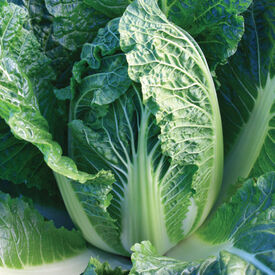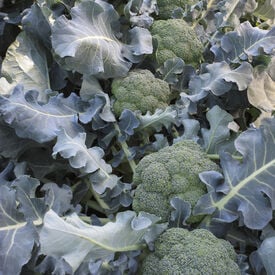The Cincinnati Market Radish is a uniquely skinny and elongated pink to red radish that is a fresh-from-the-garden-favorite! This six inch variety has a delicately mild taste with a very tender and crisp texture, making it perfect for fresh eating. The early maturing radish has been an heirloom garden favorite since 1885. You can enjoy the delicious Cincinnati Market from spring to fall.
Michihili cabbage is great for those who love stir-fry or pickling cabbage. A tight-head type with well blanched, crisp and tender interior. Michihili produces a cylindrical, leafy head. A high yielding cabbage with excellent flavor. Chinese cabbage nutrients include vitamins A and C.
The White Russian Kale is a delicious dark green oak leaf cut kale with white stems that is amazing when cooked or eaten raw. This variety has a crisp sweet flavor that only intensifies when it is cooked. This popular kale is also disease resistant.
Early maturing cabbage with tight heads! Stonehead is a fast grower with 6" heads that average between 4-6 lbs. when mature. Good texture and flavor. This hybrid resist yellow and black rot very well. A great market variety that matures early, won't split and holds well after harvest. Grows well throughout the United States. An All American Selection winner in 1969.
A 1918 The Great Northern Seed Company says this variety is not withstanding its immense size. This variety does not get hollow or pithy and its flesh remains sparkling white, solid, crisp and juicy. This slower bolting variety has the mildest flavor with a tender, crunchy texture.
China Gold (F1) cabbage has exceptional color both inside and out. It has a compact frame, good weight and is very slow bolting.
SuperStar is a hybrid cabbage that produces the highest quality fresh market cabbages. It has excellent wrappers for a fancy pack along with excellent holding ability in the field and after harvest.
The Dwarf Siberian Kale leaves are perfect as a garnish and in hearty winter dishes. This frilly green and purple kale dances in the crisp early morning cold and thrive. Why? Because its roots are from Russia!
The Prizehead Lettuce produces luscious slow bolting heads of loose, large green leaves with curled maroon tips. This variety is a popular lettuce for both home gardens and markets. Prizehead is truly a prize for its flavor being great in salads and sandwiches.
Freckles Lettuce gets its name for being an unusual bright green romaine lettuce with crimson freckles! This uniquely colored lettuce is sun-loving and grows upright. This variety has a crisp texture that can be harvested early or late!
The Avalanche beet, scientifically known as Beta vulgaris var. conditiva 'Avalanche,' is a popular variety of beetroot that has gained recognition for its exceptional characteristics. Historically, beets have been cultivated for thousands of years, with evidence of their consumption dating back to ancient civilizations like the Egyptians and Greeks. The Avalanche beet is a modern cultivar that has been selectively bred for its unique attributes. Avalanche beets are renowned for their mild, sweet flavor and tender texture. They are typically harvested at a smaller size, around 2-3 inches in diameter, making them ideal for salads, roasting, and pickling. The days to maturity for Avalanche beets range from 45 to 50 days, making them a relatively quick-growing crop. These beets are characterized by their crisp, pure white flesh and skin, giving them their distinctive appearance. They are also known for their resistance to common beet diseases such as Cercospora leaf spot and Rhizoctonia root rot, which can help ensure a healthy yield. When growing Avalanche beets, it's essential to provide them with well-draining, loose soil that is rich in organic matter. They thrive in full sun but can tolerate partial shade. Proper spacing is crucial, with rows spaced about 12-18 inches apart and individual beets planted 2-4 inches apart within the rows. Adequate watering is necessary to keep the soil consistently moist, but not waterlogged. With the right care and growing conditions, Avalanche beets can yield an abundant harvest of these delightful, mild-flavored, and visually striking vegetables.
The Lincoln Pea is an extra tender variety with a sweet flavor and high yields. This pea variety was introduced just after World War II during the peace time. Lincoln quickly became a popular home garden variety due to its versatility, as it can be eaten fresh, froze or canned. Its pods can reach 4-5" in length and are full of 6-9 sweet, tender peas. Lincoln does well in heat and should have a small pea fence or some sort of support or its vines.
The Oregon Giant Pea plant has excellent yield potential. This variety is a home garden favorite that offers a great flavored pod if eaten while young and its peas have a great sugar flavor!
Cylindra beets, also known as "Formanova" or "Butter Slicer," are a unique variety of beetroot known for their elongated, cylindrical shape. These beets have a fascinating history, originally hailing from Europe, particularly Denmark, where they were developed in the early 20th century. Their distinctive shape was cultivated to make them easier to slice and can, a practical innovation that has made them popular among home gardeners and commercial growers alike. In terms of taste, cylindra beets are mild and sweet, with a slightly earthy flavor. They are known for their tender, non-fibrous texture, making them excellent candidates for pickling, roasting, or slicing thinly for salads. Their deep red-purple skin contrasts beautifully with the vibrant, dark red flesh inside, adding an attractive element to culinary dishes. Cylindra beets typically grow to be 6-8 inches in length and 2 inches in diameter. They are ready for harvest in approximately 55-65 days from planting, making them a relatively quick-growing beet variety. They thrive in well-drained, loamy soil with full sun exposure. When it comes to disease resistance, cylindra beets tend to be more resistant to common beet diseases like leaf spot and powdery mildew than some other beet varieties. Proper spacing is crucial, with about 2-3 inches between each plant and rows spaced 12-18 inches apart. With the right care and growing conditions, cylindra beets can yield a bountiful crop of these delicious and uniquely-shaped vegetables, making them a favorite among gardeners and chefs.
The Danver 126 is a durable, multipurpose carrot that produces high yields. Danver 126 was bred by the Eastern States Farmers Exchange from selections of heat resistant strains of carrots. This carrot is improved for better interior color, smoother skin, better uniformity and better yield. Released in 1947. Excellent for home gardens and markets.
The Lutz Green Leaf White Stem Beet is an attractive deep red variety with white stalks that is absolutely delicious when steamed or roasted. This beet is known for having huge glossy, deep green tops that are perfect for salads! This beet is a "winterkeeper" beet that has a long standing storage capability. The Lutz Green Leaf White Stem has 6 inches in diameter roots.
China King is a miniature (baby) type of Chinese cabbage. Excellent for planting in close spacing as it has a compact frame. It has barrel-shaped heads with yellow interior color. Early maturing and slow to bolt.
Godzilla is a new broccoli that produces very heavy and small-beaded heads. Leaf attachments are small and lower on the stem, allowing for quick trimming and easier harvest. Heads are fine-beaded and have very heavy florets.
